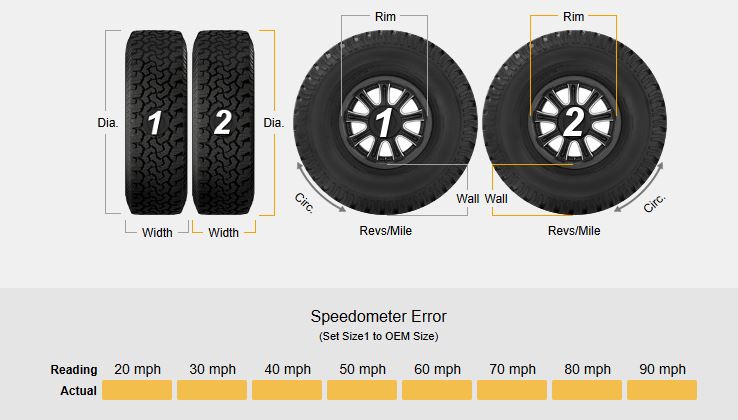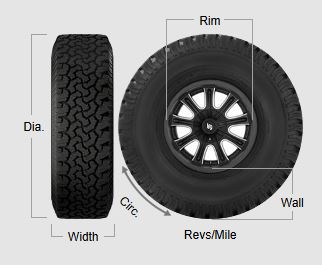Tyre Size Calculator
Calculate tyre size, compare tyres, and determine speedometer differences

Easy Tyre Size Detection
Scan your license disc or snap a picture of your tyre & we will obtain the tyre size for you on the mobile app.
Else upload a picture of your tyre on the website and we will identify the tyre size for you.
No more guessing or manual measurements - our smart scanning technology makes it easy to identify your exact tyre specifications.
Get competitive quotes from verified tyre suppliers
Tyre Size Comparison
Original Tyre Size
New Tyre Size
Comparison Results
Visual Tyre Size Comparison

Visual representation showing how different tyre sizes compare in overall diameter and sidewall height.
How to Read Tyre Size

Width (225)
The tyre width measured in millimeters from sidewall to sidewall.
Aspect Ratio (50)
The tyre's sidewall height as a percentage of the width. A 50 series tyre has a sidewall height that's 50% of the tyre's width.
Construction (R)
R indicates radial construction. Most modern tyres are radial.
Wheel Diameter (17)
The diameter of the wheel the tyre fits, measured in inches.
Understanding Tyre Size Calculations
Our comprehensive tyre size calculator computes the diameter, width, sidewall height, circumference, and revolutions per mile for any tyre size. Simply enter a metric or standard tyre size and get instant calculations with detailed comparisons.
Metric Tyre Size System Explained
While inch measurement tyres are straightforward, metric tyres use a more complex sizing system. Understanding this system is crucial for proper tyre selection:
- First Number (Width): Tyre width in millimeters. Convert to inches by dividing by 25.4
- Second Number (Aspect Ratio): Sidewall height as a percentage of tyre width
- Third Number (Wheel Diameter): Wheel diameter in inches, usually preceded by "R"
Calculation Formula for Metric Tyres
Diameter Formula: (Width × Aspect Ratio ÷ 2540 × 2) + Wheel Diameter
Example: 285/75R16 = (285 × 75 ÷ 2540 × 2) + 16 = 32.8 inches
Tyre Size Comparison Benefits
Our tyre comparison calculator analyzes two different tyre sizes and provides detailed measurements including diameter, width, sidewall, circumference, and revolutions per mile. As an added feature, it shows how your speedometer reading compares to actual speed when switching tyre sizes.
Speedometer Impact
Understanding speedometer variations is crucial when changing tyre sizes. Larger tyres have greater circumference, covering more distance per revolution. Since speedometers measure tyre revolutions rather than actual distance traveled:
- Larger tyres = Actual speed is faster than speedometer reading
- Smaller tyres = Actual speed is slower than speedometer reading
Why Use Our Calculator?
Our tyre diameter calculator eliminates guesswork when selecting alternative tyre sizes. Whether you're looking for performance upgrades, aesthetic improvements, or need to find equivalent sizes, our tool provides accurate calculations and suggestions to help you make informed decisions about your vehicle's tyres.
Tyre Size Calculator Charts
Select a wheel size to view all compatible tyre sizes grouped by overall diameter.
Tyre Size Calculator Chart for 13" Wheels
21" Tyre Diameter
22" Tyre Diameter
23" Tyre Diameter
24" Tyre Diameter
Plus Sizing Explained
What is Plus Sizing?
Plus sizing is the practice of replacing your vehicle's original equipment wheels and tyres with larger diameter wheels and lower-profile tyres that maintain the same overall tyre diameter.
Benefits:
- Improved handling and cornering
- Better steering response
- Enhanced appearance
- Potentially better braking performance
Important Considerations
Potential Drawbacks:
- Rougher ride quality
- Higher tyre replacement costs
- Increased risk of wheel/tyre damage
- Possible increased road noise
⚠️ Always Remember:
- • Keep overall diameter within 3% of original
- • Check vehicle clearances
- • Consider load ratings
- • Consult a tyre professional
Frequently Asked Questions
Do tyres expire?
Yes, tyres do expire. Tyres have a lifespan of 6-10 years from the date of manufacture, regardless of tread depth or usage. The rubber compounds deteriorate over time due to exposure to heat, oxygen, UV light, and ozone, causing the tyre to become unsafe.
How to Check Tyre Age:
- DOT Code: Look for a 4-digit code on the tyre sidewall (e.g., "2318" = 23rd week of 2018)
- Replace tyres over 6 years old even if they look good
- Never use tyres over 10 years old regardless of condition
- If a Tyre shop gives you a huge discount on a tyre CHECK THE TYRE DATE!
Signs of tyre aging include: cracking in sidewalls, hardening of rubber, loss of flexibility, and reduced grip. Even unused new tyres stored in tyre shop warehouse or in garages expire due to age-related deterioration.
Can I use a different tyre size than what's recommended?
You can use different tyre sizes, but it's important to maintain the same overall diameter to avoid affecting your speedometer, odometer, and vehicle dynamics. Always consult with a tyre professional.
What happens if my speedometer is off?
An inaccurate speedometer can lead to speeding tickets and affect your odometer readings. It can also impact your vehicle's ABS, traction control, and other systems that rely on wheel speed sensors.
Is it safe to mix tyre sizes?
Generally, it's not recommended to mix tyre sizes on the same axle. Some vehicles allow different front and rear sizes (staggered fitments), but this should be done according to manufacturer specifications.
How do I know if a tyre will fit my car?
Check your vehicle's door jamb, owner's manual, or current tyre sidewall for the original tyre size. Ensure any replacement maintains similar overall diameter and doesn't interfere with wheel wells, suspension, or steering components.



